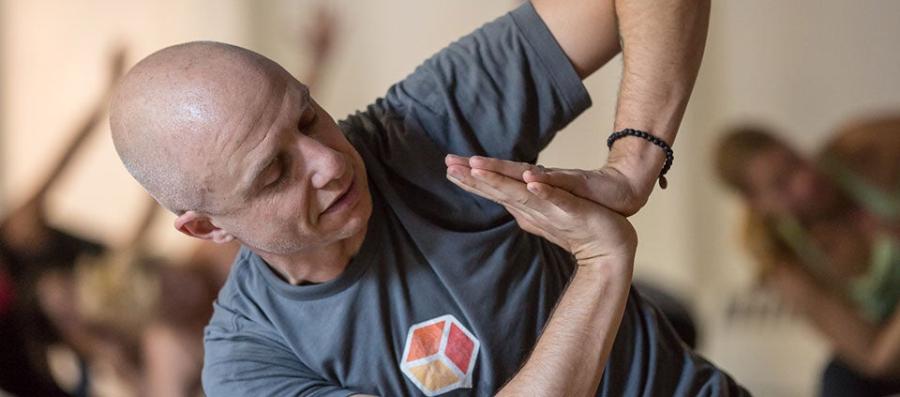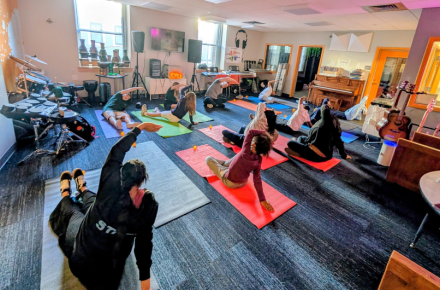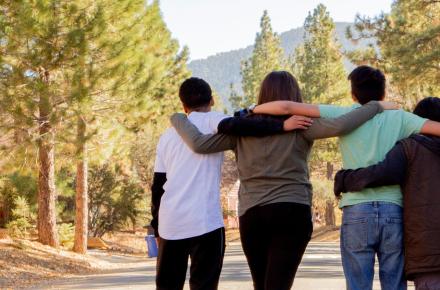Using Our Somatic Intelligence to Recover Our Resilience


Our most basic responses to all of life’s challenges and adversities begin in our bodies, so we need body-based tools of breath, touch, movement, and visualization to recover our natural baseline physiological equilibrium. We learn to “keep calm and carry on.” Here’s how it works from a neuroscience perspective.
Scanning for Safety or Danger
You might remember learning in high school biology about the autonomic nervous system (ANS), the unconscious perceptions and responses of your body-brain to signals from the environment, especially about safety and danger. Your ANS constantly scans the environment, including your people environment, for cues of safety, danger, or life threat to your physical survival and your psychological well-being.
This scanning and signaling comes from deep in the brain stem and spinal cord, operates 24/7, even when you are asleep, and always operates outside of your awareness. Your higher brain can, however, become aware of this signaling. In fact, the oversight of your higher brain is necessary to interpret what this signal really means, based on your experience and conditioning. But your higher brain is more complicated, more comprehensive in its evaluation of what’s happening and what you should do about it. It is also slower at its job. Your prefrontal cortex takes more time—whole seconds to many minutes—to respond than the faster (milliseconds) simpler, automatic reactions of the body-based ANS.
You’ve probably also learned along the way that the sympathetic branch of the ANS “revs you up” to take immediate action when you feel uneasy or sense danger. This rapid, protective reactivity of fight-flight gets your body moving—now—to tackle or flee from the danger, to confront or flee from a person who seems unsafe or toxic.
Your lower brain tells your body to move before your higher brain is even aware that something has just happened. The reactions of your nervous system keep you alive before your conscious brain can even register you might be in danger of being dead.
Along these same lines, you’ve probably learned that the parasympathetic branch of the ANS allows you to calm down, to “rest and digest,” when the danger is over. These two branches operate like the gas and the brakes in a car; you’re either stepping on the gas (activating the sympathetic) or the brakes (activating the parasympathetic), but not both at the same time.
There are many benefits to activating the sympathetic branch (SNS) when there is no danger. For example, it’s what gets us moving out of bed in the morning, gets us to want to get out of bed in the morning, gets us to engage with people and explore the world and play and create and produce. Thanks to the SNS, we create governments; we write symphonies; we take action to build buildings and solve the problems of climate change. Positive activation of the SNS, regulated by the pre-frontal cortex, is the basis of human civilization as we know it.
Similarly, activating the parasympathetic (PNS) when there is no danger allows us to feel centered and grounded, at peace and at ease. The positive activation of the PNS, regulated by the prefrontal cortex, is the basis of personal well-being as we know it. You know this as the feeling you get when you take a nap on the beach, or relax in a contemplative stillness, or fall asleep after making love.
It’s when either the SNS or the PNS over-activates in response to perceived danger or life threat that things can get tricky. A sudden spike of the sympathetic can rev you up into anger/rage or anxiety/fear/panic. A sudden collapse into the parasympathetic can cause you to numb out, shut down, withdraw, dissociate. That over-revving up or over-shutting down can even derail the functioning of your higher brain altogether, at least temporarily. At which point you are reacting solely out of your automatic survival responses and whatever conditioned learning got encoded in your brain’s neural circuitry early on. This is your neurobiology. It’s instant and it’s potent.
Unfortunately, the SNS can get stuck in “on” mode. Rather than having to deal with acute threats to your physical safety, as generations of our ancestors did, as modern humans we more often face chronic threats to our psychological and relational safety and well-being.
Relentless pressures at work, constant complaints and criticisms from people we take our cues of self-worth from, falling short in achieving goals or in constant comparisons to others or to our own expectations, no end of worry about the future. We rev up and don’t take a break, don’t get a break; we remain anxious and vigilant and can’t recover that sense of safety and calm that is essential to our well-being.
In the other direction, the PNS can get stuck on the “off” mode. Relentless boredom at work, too many losses or disconnections from people important to our well-being in too short of a time. Rather than activating, showing up to engage and deal, we can go into dissociation, denial, despair, withdraw into passivity, stay collapsed in a learned helplessness or depression, not having the energy or motivation to try and try again. From millions of years of evolutionary biology, to play dead so the lion won’t eat you. From thousands of years of evolving in social groups, withdrawing or appeasing so the tribe won’t throw you out.
Recovering the Brain’s Sense of Safety
What sophisticates our understanding of our nervous system, and gives us a third option in regulating the revving up or the shutting down out of the range of resilience, is that just 20 years ago, neurophysiologist Dr. Stephen Porges discovered a third branch of the ANS, which he calls the “social” vagus, a neural pathway that travels up from the body and brainstem, connecting with nerves in the neck, throat, eyes and ears. This ventral vagus pathway, as it’s called (communicating between the face and the heart), is what allows you to feel safe when you’re connected to safe people.
Human beings are social beings, born and raised in families, kinship groups, and communities, and the brain is evolutionarily hardwired to reach out and connect with others, to seek reassurance from others when a sense of safety and well-being has been disrupted. The social engagement system can perceive, even unconsciously, signals of “It’s okay; false alarm; you’re fine; you’re safe.” This is the neurobiological basis of secure attachment and an inner sense of safety and calm. It’s also the neural platform for taking risks when necessary.
Using your social engagement system to generate an inner sense of safety doesn’t necessarily mean circumstances are safe yet—the threat of foreclosure on a house or your back going out just bending over to tie your shoe may still be happening and you need to be resilient in coping with them, but there’s an inner neuroception of calm and equilibrium.
When the ventral vagus pathway is fully mature and functioning well, it acts as a brake on the spikes of your sympathetic nervous system. It acts as a safety net before you drop into the shutting-down swamp of your parasympathetic. You may react in your body, but your brain can maintain a sense of balance and presence and recover from a wobble fairly quickly. You trust yourself—“I’ve been through worse before; I can learn to deal with this now.” You trust other people around you as resources—you become calm because they are calm; you trust yourself to cope because they trust your capacities to cope.
Recovering Safety Through Other Brains
Barbara Fredrickson, pioneering researcher in positive psychology, discovered how this might happen. She found that when two people are in physical proximity, making eye contact, sharing positive emotions, (kindness, enthusiasm, joy) and a sense of mutual care and concern, the neurochemistry of the two people’s brains begins to sync up, creating a sense of resonance between the two brains that I would call safety and trust and which she calls love in her book Love 2.0. That neuroception of safety is what helps the brain relax and become more open to learning again. That sense of safety primes the neuroplasticity of the brain for learning and rewiring, thus strengthening our resilience.
Try this exercise …
Do this exercise with a person you feel safe with.
- Simply sit near each other in comfortable physical proximity.
- Smile at each other in a genuinely open, friendly way.
- Maintain eye contact.
- Feel within yourself a sense of kindness, care, interest, concern for the welfare for the person you are sitting with; let your facial expressions convey that kindness and concern.
- Let yourself take in that this person cares about your well-being as well; observe their facial expressions conveying that.
- Simply savor this moment of connection—30 seconds of neurochemical connection that may allow your nervous system to relax, feel at ease, and be more ready for learning and growth.
Truly, this sitting and savoring connection can work extremely well to help you feel calmer and safer, even in the midst of overwhelming trouble or tragedy.
Find out about upcoming programs with Linda Graham at Kripalu.




















































